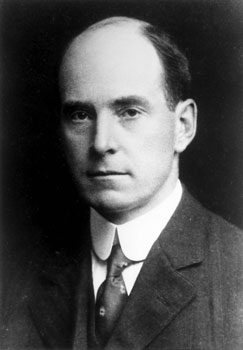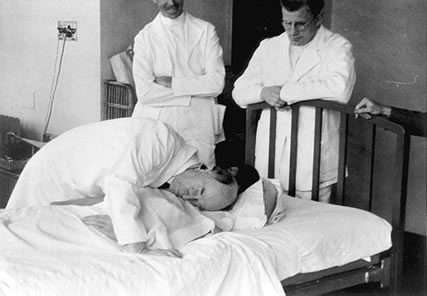Philip R. Liebson
Chicago, Illinois, United States

Dr. Lewis Atterbury Conner (1867–1950) was the chief of the New York Hospital medical service. He made rounds with the medical staff even on Sundays, when he would come from church wearing a morning coat, wing collar, and striped trousers. Unfortunately, he was very hard of hearing, yet this would not detract from claiming expertise in auscultation. In association with New York cardiologists, among others, he was instrumental in the founding of the American Heart Association in 1925 and the American Heart Journal (until 1950 the only trade journal of American cardiology). As chair of the second (Cornell) medical division of Bellevue Hospital, he was also responsible for fostering its outstanding reputation in patient care and teaching.
Dr. Conner was largely responsible for improving cardiology care in the modern hospital. In the early 1920s, there was no medical center as such in New York City. The major medical centers, such as the Columbia-Presbyterian Medical Center and the New York Hospital-Cornell Medical Center, were still a dream. Most of Cornell’s medical students were trained near or at Bellevue on First Avenue in the 1920s and Columbia students were trained primarily at Roosevelt Hospital on the West Side at 59th Street, where the medical school was then situated. There were physicians specializing primarily in cardiology, but there were no dedicated cardiology sections, no American Heart Association, and no specialty cardiology journals. The Presbyterian Hospital was then situated on Park Avenue in the 1960s and the New York Hospital on Fifth Avenue at 16th street. The medical floor, consisting of two large open wards, one for men and one for women, was reached by an old elevator manipulated by the passenger pulling ropes. The ambulance service was provided by an electric-powered vehicle with hard rubber tires and an open back where uniformed interns traveled clutching a pole to keep their balance.
Like many of the outstanding New York physicians at the time, he trained at Columbia’s College of Physicians and Surgeons, graduating in 1890 after undergraduate work in philosophy at Yale’s Sheffield Scientific School. His career, however, was in the Cornell environment. He trained at New York Hospital from 1890 to 1892, then toured Europe and visited the Kiel clinic of Heinrich Quincke of Quincke pulse fame. Aside from his studies on aortic regurgitation, Quincke was developing lumbar puncture. Conner brought several of Quincke’s needles back with him and performed himself a lumbar puncture on a patient in New York City, perhaps the first lumbar puncture done in the United States.
When the Cornell Medical School was founded in 1898, he became an instructor and, in 1900, became a clinical professor at the age of 33. He was active at both New York and Bellevue Hospitals, and became chair of the Cornell Department of Medicine in 1916. He remained chair until 1932, when New York Hospital and the Cornell Medical School merged as the New York Hospital-Cornell Medical Center on First Avenue and 68th Street in 1932. The Cornell Medical Division at Bellevue had some outstanding clinical investigators, including Eugene F. Du Bois, who studied basal metabolism and eventually replaced Conner as chair of medicine. In the 1920s, Dr. Du Bois was head of the residency program at the Second Medical Division. In addition to New York Hospital and the Second Medical Division, patients were seen in the medical school building itself. Called the Cornell Clinic and inaugurated by Conner, its major purpose was to provide medical students with a model of good ambulatory practice. The important foundational work was done at Bellevue.
As with many young physicians before the 1920s, he served in the military, as a private in the Spanish-American war and senior medical officer in the US Army during World War I. He was, in fact, chief of the Army Medical Corps Division of Internal Medicine during the War, and made important contributions to the standards of physical examination, assisting in the revision and clarification of standards of the cardiovascular examination, and selecting and training cardiovascular specialists. In addition to standardizing the cardiac physical examination, he later suggested requirements for ensuring the accuracy of commercial clinical laboratories.
On a personal note, it is possible that Conner was partially responsible for the Detroit Tigers winning the pennant in 1945. My uncle was an army officer early in WWII and did physical examinations of potential recruits in the Detroit area. A pitcher for the Tigers, not yet a spectacular one at the time, was having his Army physical in 1942, and my uncle, using some of the cardiovascular examination standards engendered by Conner, detected a heart murmur. He was of course rejected, but went on to win over twenty games in 1945 and led the Tigers to the pennant in that year.

Until the late 1960s the most prestigious gatherings for subspecialists in medicine were the Federation Meetings in Atlantic City every Spring. The leading research prestigious group was the Association of American Physicians. In 1919, Conner presented some of his experiences before the group in the paper “Cardiac Diagnosis in the Light of Experiences with Army Physical Examinations.” His focus was on the wartime assessment of cardiac diagnosis, pathogenesis of cardiac disorders, and functional as well as structural disorders of the heart. Many of his findings became the basis for the later New York Heart Association criteria for cardiac disease, still a standard for guidelines.
Conner was instrumental in the formation of the New York Heart Association in the early 1920s and the American Heart Association in 1925, becoming its first president. The AHA headquarters remained in New York until the late 1960s, when it moved to the Dallas area. In 1925, he also became editor of the newly founded the American Heart Journal, which for many years was the official journal of the American Heart Association. The Journal not only focused on papers on circulatory disease in general, but importantly, also on public health issues involving the cardiovascular system—thanks in part to Conner’s interest in public health and rehabilitation.
His interest in public health was fostered early in his career and he helped in the establishment of cardiac convalescent homes, cardiac classes, and specialty outpatient clinic programs. He was especially concerned with the cost of cardiac care and, in a 1927 paper, demonstrated the differential cost of cardiac hospital care ($30/week), convalescent home care ($12/week) and special cardiac clinic ($1/visit). (This would be the equivalent of $378, $151, $12.60 respectively in 2012 dollars, still relatively inexpensive compared with today’s average costs.)
As for his auscultation technique, Conner was, as I mentioned above, quite hard of hearing and listened directly to the patient’s chest using his ear, separated from the patient by a thin towel or handkerchief.
Following his retirement as chair of medicine at Cornell at the age of 65, he became medical director of the Burke Convalescent Home, a subsidiary of the medical center. While examining patients there, he astounded younger clinicians by his direct auscultation of the chest and palpation of the cardiac apex. By such techniques, he would diagnose, without the use of a stethoscope, such diverse conditions as lung abscess and mitral stenosis.
Conner’s contributions to the medical literature included early papers on lumbar puncture and the depressive cardiac effects of quinine, then used in cold medicines. Although the stethoscope was an important part of the physician’s diagnostic armamentarium in examining the heart, he emphasized the importance of looking at the venous pulse, in addition to percussion and palpation. He also evaluated the benefits and limitations of the newer technique of chest radiography and fluoroscopy.
In my experience at Bellevue Hospital, as late as 1967, the standard approach to evaluation of heart chamber sizes was a “cardiac series,” or four views of the chest, and fluoroscopy was still used to determine cardiac motion and calcifications. Of course, echocardiography was in its infancy at that time.
His later papers dealt with state-of-the-art summaries involving such conditions as “coronary thrombosis,” rheumatic heart disease, pulmonary emboli, and cardiac neuroses.
At the time of his death, in 1950, a new journal, Circulation, was founded and replaced the American Heart Journal as the official journal of the American Heart Association. A lecture named in his honor is now a part of each annual meeting of the Association.
References
- Wooley CF, Schneider D, Lerner AA. Lewis Atterbury Conner. Appreciation and bibliography. Circulation 1998; 98:1449-1455.
- Wooley CF. Lewis Atterbury CFonner. Clinical Cardiology 2007;30:257-259.
- Reznikoff P. In medicine, a chief distinguished in research moves uptown from Bellevue. Cornell University Medical College Quarterly 1982;45: 17-19
PHILIP R. LIEBSON, MD, graduated from Columbia University and the State University of New York Downstate Medical Center. He received his cardiology training at Bellevue Hospital, New York and the New York Hospital Cornell Medical Center, where he also served as faculty for several years. A professor of medicine and preventive medicine, he has been on the faculty of Rush Medical College and Rush University Medical Center since 1972 and holds the McMullan-Eybel Chair of Excellence in Clinical Cardiology.
Highlighted in Frontispiece Volume 5, Issue 2 – Spring 2013

One response